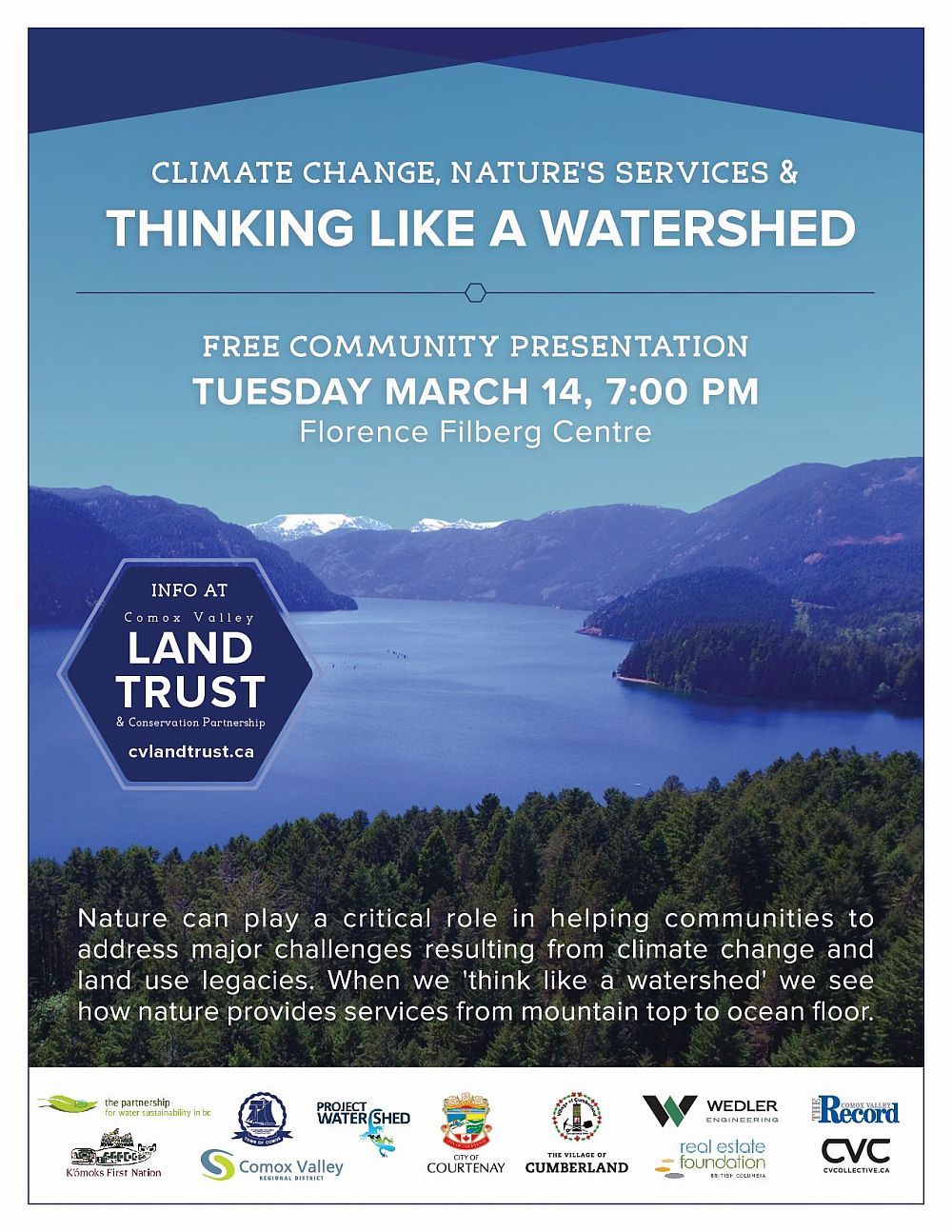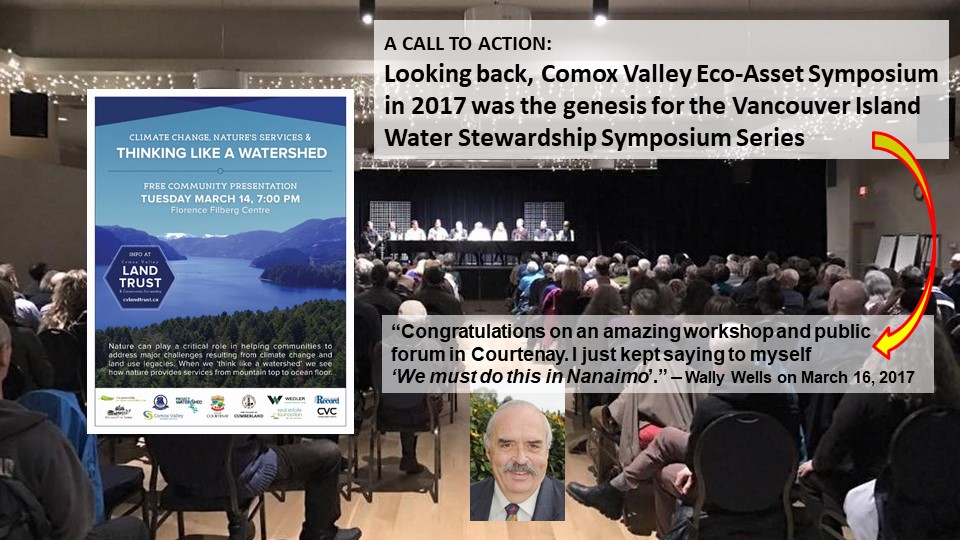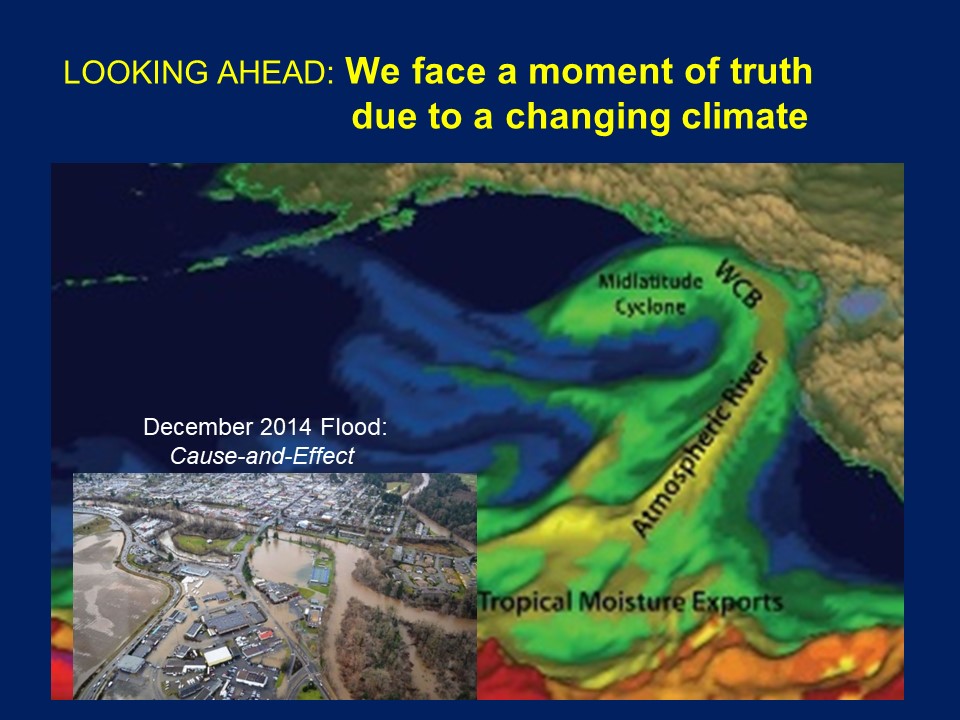FLASHBACK TO 2017: Climate Change, Nature’s Services & Thinking Like a Watershed—the Comox Valley Eco-Asset Symposium was an energizing moment; ripple effects included being the catalyst for an inter-regional conversation that resulted in the launch of the “Vancouver Island Symposia Series: Water Stewardship in a Changing Climate” in 2018
Note to Reader:
The Comox Valley on Vancouver Island is facing a long list of challenges as more frequent and intense winter storms and summer droughts overwhelm engineered infrastructure and natural systems (that have been degraded over time by land use activities). It is feast AND famine! Now, the four local governments in the valley are facing a total cost approaching $200 million for proposed engineered infrastructure solutions to these problems.
In March 2017, the 23 environmental and ratepayer groups comprising the Comox Valley Conservation Partnership hosted a symposium to explore less expensive ‘design with nature’ solutions. Sponsors include the City of Courtenay, Comox Valley Regional District, Village of Cumberland and Real Estate Foundation of BC. The Partnership for Water Sustainability in British Columbia was a key symposium partner, with contributions including program content and event promotion.
The symposium spotlight was on the potentially powerful and cost-effective role that ecosystem services can play in an infrastructure strategy. The event attracted an audience of 180-plus, and the majority came from outside the Comox Valley, and from as far away as the East Kootenays.

Exploring Eco-System Services and Eco-Asset Management Opportunities in Comox Valley Watersheds
“The purpose of the Symposium was to build local knowledge and interest in how to apply eco-asset management principles at the local level. The Symposium was very much about setting in motion a mind-set change. It was therefore essential that everyone step back and see the big picture,” stated Tim Ennis, Executive Director, Comox Valley Land Trust.
“The Symposium was structured around a series of workshop segments that assessed natural systems opportunities in the upper, mid and lower watersheds. Educational outcomes were modest. The measure of success was that participants would understand the concept to ‘think like a watershed’, believe that it can be done, and commit to playing a role so that it will happen.”
A tag-team presentation by Kim Stephens (Executive Director, Partnership for Water Sustainability), Michelle Molnar (Suzuki Foundation) and Jim Dumont (the Partnership’s Engineering Applications Authority) provided context for three concurrent workshops on the upper, mid and lower watersheds. The co-presentation was structured as a conversation, and in two parts. In the first part, the speakers presented core concepts. In the second part, Kim Stephens facilitated a town-hall sharing and learning session.

Capacity crowd for the Comox Valley Eco-Asset Symposium, held at the Filberg Centre in the City of Courtenay on Vancouver Island
To protect watershed health, engineered infrastructure ought to fit into natural systems, rather than the other way around
“The stewardship and conservation sector has traditionally focused on habitat restoration and protection of lands with high ecological values,” stated David Stapley, (former) Program Manager with the Comox Valley Conservation Partnership, and now a Director of the Comox Valley Land Trust.
 “With cumulative impacts from climate change, urban and resource development escalating, these groups have now become community leaders in educating and supporting improved land use practices.”
“With cumulative impacts from climate change, urban and resource development escalating, these groups have now become community leaders in educating and supporting improved land use practices.”
“To address these escalating challenges, the Eco-Assets Symposium promoted measures that capture the value of ecological assets to address infrastructure and climate change issues by integrating them into land use planning and practice.”
Symposium Objectives
“Broadening collaboration to include the stewardship, conservation and industry sectors would build understanding and improve practises in the field. The Symposium was an opportunity for land use professionals, stewards, local governments, First Nations and Industry to come together,” continued David Stapley. He identified these objectives:
- Bring together professionals, community leaders and local government to build energy and interest toward an Eco-Asset Management approach to addressing critical community infrastructure issues.
- Build capacity around Eco-Asset Management principles and to provide participants with tool kits to bring back to their respective shops.
- Set the stage for developing the business case for Eco-Asset Management in the Comox Valley.
- Contribute to innovative problem solving and action toward local initiatives. (Watershed Protections Plan, Estuary Restoration etc)
- For the Comox Valley Land Trust and Community Partnership, be a catalyst for subsequent Eco Asset Management processes with symposium participants.
“These objectives were fulfilled. The 2017 Comox Valley Eco-Asset Symposium was an ‘energizing moment. The ripple effects included being the catalyst for an inter-regional conversation that resulted in the launch of the Vancouver Island Symposia Series: Water Stewardship in a Changing Climate as a collaborative effort by the Partnership for Water Sustainability, Nanaimo and Area Land Trust (NALT), and the Regional District of Nanaimo,” stated Kim Stephens when the series was launched in Nanaimo in April 2018.

To Learn More:
Download the Agenda and Presenters List for the 2017 Eco-Asset Symposium.
Visit the Symposium homepage on the Vancouver Island Water community-of-interest.
Download Comox Valley Eco-Asset Management Symposium – Discovering Nature’s Infrastructure Potential. Released prior to the symposium via WaterbucketNew, this document was written to inform those in a province-wide readership who might be curious, as well as establish expectations among those who decided to register.
Click on the image to watch the video titled “Thinking Like a Watershed: Eco-Assets Explained”. The video interweaves the perspectives provided by Bob Sandford, Emanuel Machado (CAO ,Town of Gibsons), Kim Stephens and Michelle Molnar to capture the essence of the Comox Valley Eco-Asset Symposium.
Moving Towards Sustainable Watershed Systems, through Asset Management
Kim Stephens, Executive Director for the Partnership for Water Sustainability in British Columbia, delivered the keynote address at the Symposium. He connected the dots between past, present and future to prepare the audience for the breakout sessions that were the main focus of the day.
“Too often we talk about water and land as silos,” stated Kim Stephens in his opening remarks. “But what happens on the land does matter! It is whether and how we respect the land that really affects what happens with water. That is a key message. It is why we are moving forward with Sustainable Watershed Systems, through Asset Management.
It is based on this premise: natural watershed systems are infrastructure assets – we must manage and protect them as such. Starting in November 2015, the Partnership has presented the vision for Sustainable Watershed Systems, through Asset Management to an array of audiences in variety of forums and media.”
Looking Back to Understand the “New Normal”
 “When we reflect on the legacy of past community planning and infrastructure servicing practices, we see a recurring pattern of floods and droughts. That is the New Normal,” continued Kim Stephens.
“When we reflect on the legacy of past community planning and infrastructure servicing practices, we see a recurring pattern of floods and droughts. That is the New Normal,” continued Kim Stephens.
“Simply put, what it comes down to is that the natural water balance of watersheds is out of balance in the urban environment. And on top of this, as explained by Bob Sandford in his public keynote, the global water balance is out of balance.
“And if the global water balance is out of balance, then certainly the Comox Valley water balance is out of balance.”
Looking Ahead to a Moment of Truth
“Last November, Bob Sandford and I were part of the Partnership team that organized the Flow & Grow Workshop in the Okanagan. My takeaway from Bob’s keynote at that event was the notion of atmospheric rivers,” continued Kim Stephens
“A 1-degree rise in global temperature means the water vapour in the atmosphere increases by 7 percent. And we see what that means on the ground in terms of the impact of the Pineapple Express. We are at a moment of truth. Time is of the essence.
“The flood that the City of Courtenay experienced in December 2014 illustrates the local impact of a global change.”
To Learn More:
Download What Happens on the Land Does Matter! – Moving Towards “Sustainable Watershed Systems, through Asset Management” to view the storyline for the keynote address by Kim Stephens. To watch his presentation, click on the image link to a YouTube video.


